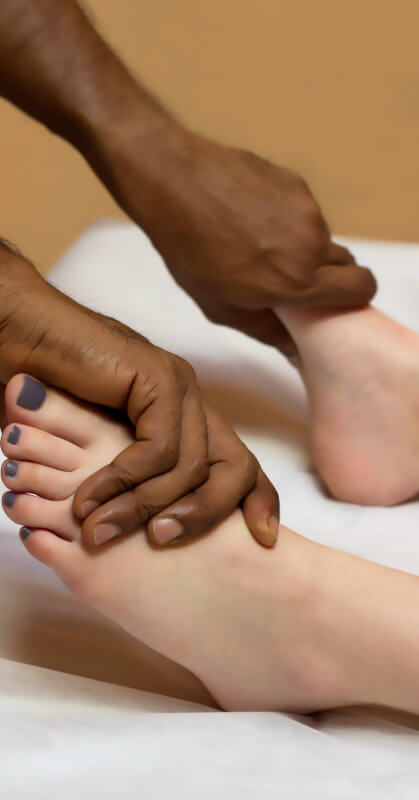4 Alternatives to Medicine for Pain Management
Oh Lardy! is a participant in the Amazon Services LLC Associates Program, an affiliate advertising program designed to provide a means for us to earn fees by linking to Amazon.com and affiliated sites.

Chronic pain isn’t something we like to talk about. It’s uncomfortable. Not only does it destroy lives, there’s no easy way to treat it. It’s not something you can just slap a Band-Aid on and declare healed. And all this “not talking” isn’t helping the millions of Americans that live with some form of chronic pain.
For many chronic pain sufferers, the first thing their doctor did was prescribe them a powerful opioid. While these drugs can be lifesavers for people experiencing certain types of chronic pain, the problem with opioids lies in addiction and misuse.
Thanks to reassurances from pharmaceutical companies that addiction was rare, doctors began prescribing opioids at greater rates in the 1990s. Consequently, large-scale misuse ran rampant before it became clear that these medications could indeed be highly addictive. As it currently stands, between 20 and 30 percent of chronic pain patients misuse opioid medications. What’s more, of the lethal drug overdoses in 2015, over 20,000 were related to prescription pain relievers.
When faced with statistics like these, it’s understandable that some chronic pain sufferers are reluctant to use opioid analgesics. Fortunately, there are alternatives to medication.
Physical Therapy
Physical therapy can be used to treat chronic pain in a number of ways. First, physical therapists can guide you through a series of exercises tailored to strengthen your muscles and joints. They can also help you learn to move in ways that don’t exacerbate old injuries or put you at risk for new ones. Second, physical therapists are experts at treating inflammation and movement dysfunction — two things that are often at the core of chronic pain. Finally, there are new forms of physical therapy designed to manipulate the central nervous into being less sensitive to pain signals.
In a 2017 study of people living with HIV related chronic pain, physical therapy was found to effectively decrease pain in 65.2 percent of the patients.
Guided Imagery
I know this sounds a little “out there,” but guided imagery has been proven to be effective in pain management! A 2004 pilot study followed 28 women with osteoarthritis over 12 weeks. The women who underwent guided imagery treatment twice a day reported a significant reduction in pain compared to the control group.
So how does it work?
Acute pain (the kind that happens after you experience an injury) appears in areas of the brain that are associated with tissue damage. Chronic pain, however, presents in the prefrontal cortex and limbic system — parts of the brain associated with memories, especially emotional ones. Chronic pain impulses like to travel along well-worn pathways, such as those formed by repeated thoughts and emotions. Guided imagery can build new nerve pathways, which makes the ones the pain uses become less active.
People who are in constant pain usually have heightened levels of stress and anxiety. Guided imagery can help reduce that stress and anxiety — which, in turn, can reduce pain. Basically, the more you’re engaged in guided imagery, the more you disassociate from pain.
Acupuncture
Acupuncture is an ancient Chinese medical practice wherein practitioners insert thin needles into your skin to alleviate pain. A 2014 research investigation looked at the results of 29 studies on acupuncture involving nearly 18,000 participants. Their overall findings revealed that acupuncture relieved pain in about 50 percent of the participants.
Acupuncture is thought to decrease pain not by “channeling life-force” but by increasing the release of endorphins. Many acupuncture points are near nerves. When these nerves are stimulated, they send a message to the the brain to release endorphins. Endorphins are essentially natural pain relievers produced by your body. They bind to the opioid receptors in your brain and block the perception of pain — much in the same way that opioid pain relievers do.
Therapy
People who live with chronic pain often bristle at the idea of seeing a therapist. Being told “it’s all in your head” is something they’ve heard too many times, often in an extremely dismissive manner. However, chronic pain can cause or worsen mood disorders such as depression and anxiety. Conversely, these mood disorders can lower a person's tolerance for pain.
Therapy can change the way you view your pain. It can help you adjust the thoughts, emotions, and behaviors related your pain and put it in a better context. Furthermore, it’s helpful in improving coping strategies. Therapy can also reduce stress. Since stress alters pain control chemicals in the brain (such as norepinephrine and serotonin), diminishing it can make the body’s natural pain relief response more powerful.
Conclusion
Before you make any appointments, take some time to do some research on the alternative treatment you’re considering. Look especially closely at the scientific evidence on its safety and efficacy. Discuss it with your doctor — they’re in a good position to advise you on its safety and recommend legitimate practitioners. Finally, look into the training and experience of any practitioner you are considering. Don’t be afraid to ask if they have experience working with your specific pain condition.
Though opioid medications have their place in treating chronic pain, non-pharmacological therapies are available to those who seek them. From physical therapy to acupuncture, there are many ways to decrease your pain, gain more control over it, and improve your quality of life. Hang in there!
Liz Greene is a dog loving, beard envying, pop culture geek from the beautiful city of trees, Boise, Idaho. You can catch up with her latest misadventures on Instant Lo or follow her on Twitter@LizVGreene.


Hi,
Very good article its very useful and healthy information.
Solid advice. Sometimes these natural solutions not only improve the situation you are dealing with but other parts of your body at the same time and leave you in a much better place.
Wow, What an Excellent post. I really found this too much informatics. It is what I was searching for. I would like to suggest you that please keep sharing such type of info.
Online Pharma Supplies
Alternative care really should be meds/surgery. Other nondrugs options should be exhausted prior to the meds.
Thank you for sharing this wonderful article. Looking forward to more!
Thank you for this nice article. Loved the information shared.
excellent article. You have provide some important information that will help uys a lot. keep writing like this blog..
thanks for sharing.
i have been looking such kinds of blog. Thanks for sharing.
Excellent article. However, you have written it very carefully. and provided us with useful information.
Thanks for sharing with us.
Thanks for sharing. It will me a lot.
Helpful article. Want more from you.
Thanks for the post Best hospital in hyderabad
Useful information. i am supporting your says that everyone should think about alternative medicine before using one. It sometimes helpful because we have to think about the reactions.
Thanks for proving us such important information.
You have given us important information. Thanks for giving us this information.
Great info in this post, thanks for putting it together and sharing it with everyone. I can also recommend physical therapy for pain management, it has changed my life by reducing my back pain.
Informative post. Thanks for sharing with us.
Thanks for sharing alternatives to common opiods which arent good for long term pain management.
Cannabis, also known as marijuana among other names, is a psychoactive drug from the Cannabis plant used for medical or recreational purposes. The main psychoactive part of cannabis is tetrahydrocannabinol, one of the 483 known compounds in the plant, including at least 65 other cannabinoids
Chronic pain can create real problems for not only the person but also rest of the family members who are at loss to give the patient something to bring the patient relief. It is for the best of patients long term general health that alternative methods like physical therapy and acupuncture proved to be effective
very helpful. I have chronic pain in right shoulder. May be I spend too much time in front of the computer. Exercise is a good way to relieve it.
What you said was absolutely correct. Thank You for giving such solid advice. We must keep these things in mind and should never ignore chronic pain.
This is very helpful. I have chronic pain in left shoulder. May be I spend too much time in front of the computer.
If you have chronic back pain, you have probably tried many different treatments. Lots of strategies can be effective for different people and different conditions, and you may find something that works well for one aspect of your pain.